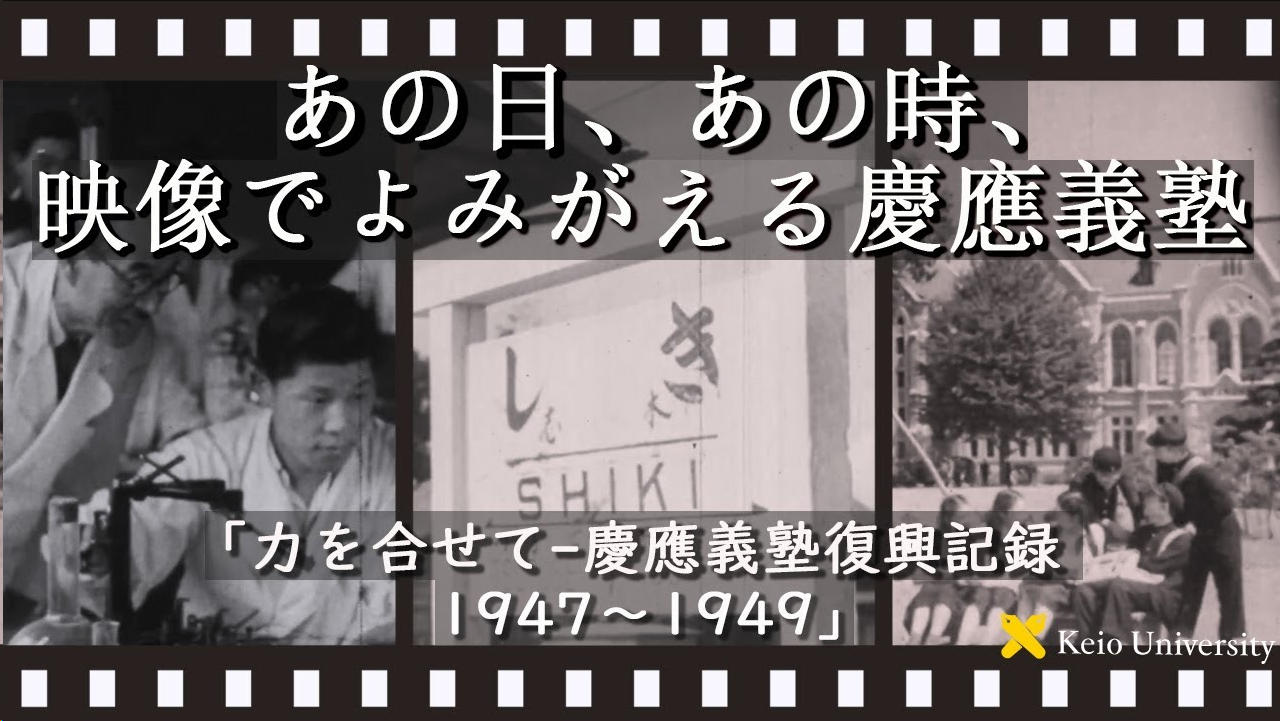Header start
- Home
- Keio Times Index
- Keio Times
Content start
Marking 80 Years Since the End of World War II: Keio University and the War at Mita and Shinanomachi Campuses
July 31, 2025
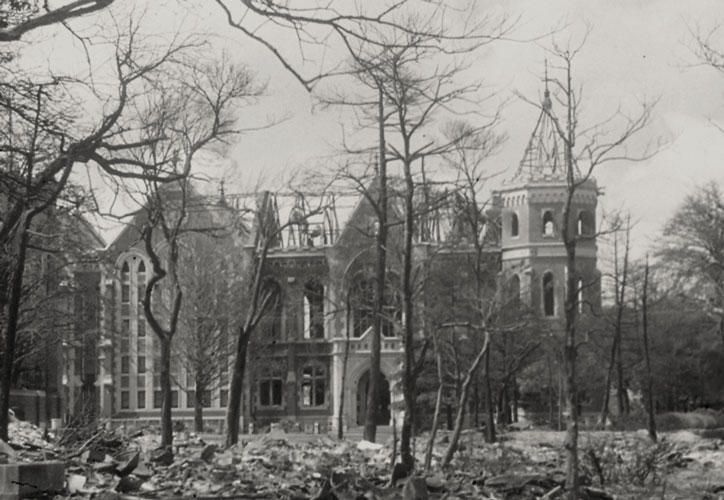
The Reconstruction of Mita Campus
Began with Keio’s Iconic Old University Library
During air raids by U.S. bombers on May 24–25 and again on the 26th, 1945, most of the wooden school buildings on Mita Campus burned down. Although the Keio Corporate Administration and Mita Public Speaking Hall survived, Keio’s iconic red-brick library lost its main reading room, administrative office, and stained glass windows to the bombing. Due to the valiant firefighting efforts of students, faculty, and staff members, as well as the prior demolition of the surrounding wooden structures in preparation for disaster, the archives were spared from fire, and many valuable documents had already been safely removed and stored elsewhere. Nonetheless, the air raids left deep scars on campus.
After the war, during Keio’s 90th anniversary celebrations in 1947, Keio announced a ten-year reconstruction plan ahead of its centennial. The first initiative undertaken was the restoration of the Old University Library, which was completed in May 1949. At that point, the broken stained glass had been refitted with plain clear glass, but that, too, was restored in 1974.
The Old University Library, which came to symbolize Keio's postwar recovery, has since undergone multiple expansions and renovations and is now preserved as an Important Cultural Property of Japan.
Campus Artworks Bear Witness to
Memories of War & the Will to Rebuild
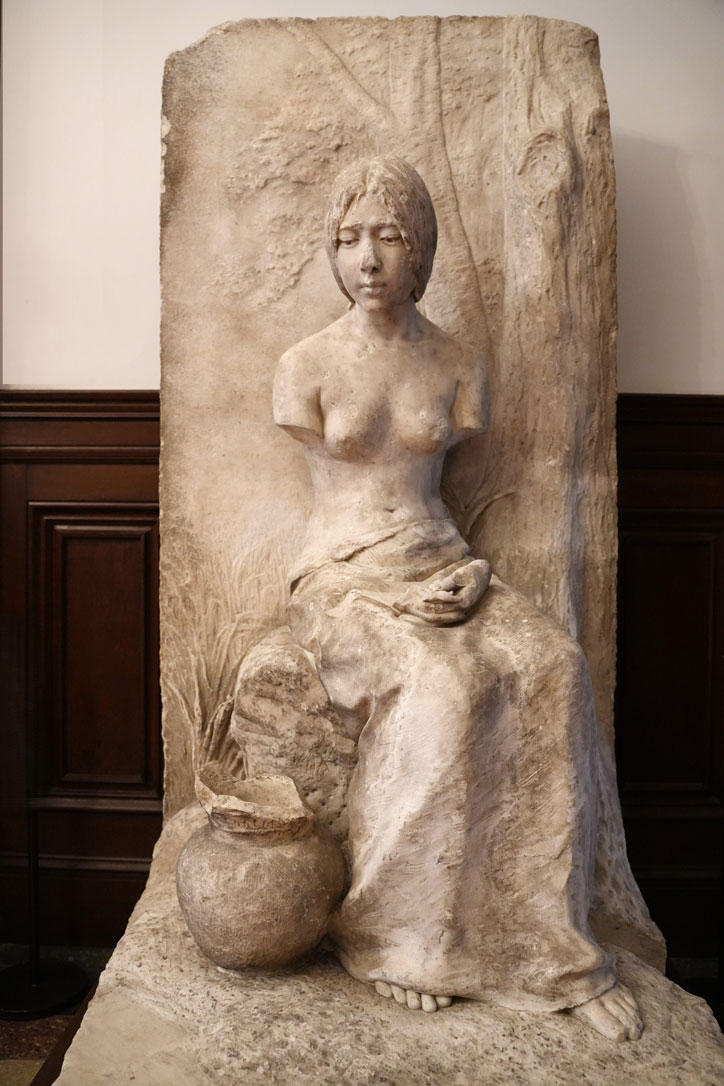
Mita Campus is home to several other artworks intended to preserve the war’s history, offer a requiem to the fallen, and embody hopes for peace. The Maiden Tekona, located on the first floor of the Old University Library, is a marble sculpture created circa 1909 by sculptor Shikai Kitamura, inspired by the tale of a tragic woman featured in the Manyoshu. Having been severely damaged by air raids, including the loss of both arms, the sculpture was finally unveiled to the public in 2009 for the first time in more than 60 years. During the preliminary restoration process, soot from the incendiary bombs was intentionally left to preserve the historical reality of the war lest its memory fade away.
Heiwa Kitaru (Coming of Peace), erected in 1952 by Fumio Asakura in the garden in front of the Keio Corporate Administration, was donated to commemorate the 25th anniversary of the graduation of the 1932 Mita-kai alumni association in memory of Keio University’s war dead. Inscribed on the pedestal is an epitaph by Shinzo Koizumi, Keio’s president during the war: “On these peaceful days atop the hill of Mita, we remember those who went to war, never to return.” In 1998, Monument to Fallen Friends was erected. In 2014, a list of Keio’s war dead was enshrined within the pedestal. Also located on the first basement floor of the Mita Media Center is Wadatsumi no Koe (Voices from the Sea), a statue created by Shin Hongo in 1950 to honor the students who died in the war.
The Student Hall was completed in 1949. Murals titled Democracy by Genichiro Inokuma adorned the east and west walls of the old student cafeteria within the hall, depicting young men and women singing and speaking freely—an image of postwar democratic liberation. After the hall’s demolition, the murals were relocated to the Co-op Cafeteria in the West School Building, where they continue to keep a watchful eye over students today. The triangular shape at the top of the mural is a remnant of the original roof from the Student Hall era.
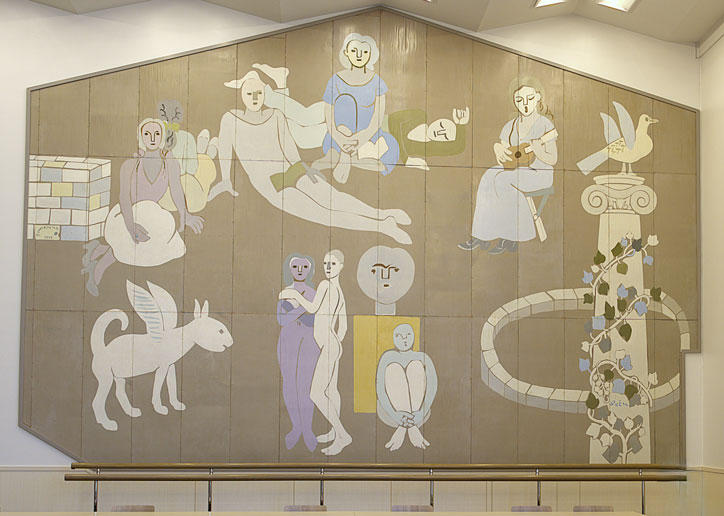
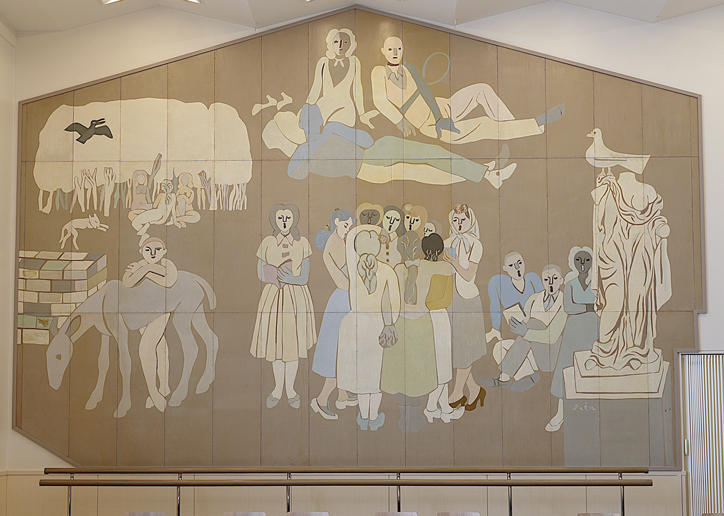
War Damage at Shinanomachi Campus &
The Struggles of the Keio Community
Shinanomachi Campus was hit during air raids beginning in the early hours of May 24, 1945, and suffered catastrophic damage. Approximately 60% of its structures were destroyed in the resulting fires. Even today, hexagonal scars left by incendiary bombs remain on the site of the Building for Preventive Medicine and Public Health, which was also burned but survived the war.
Amid a barrage of incendiary bombs, a special emergency team of faculty, staff, and students worked tirelessly to protect the campus. Their efforts spared the reinforced concrete buildings, and approximately 180 hospitalized patients were safely evacuated without any injuries. Their courageous actions were reported in the Asahi Shimbun the next day, on May 25: “Eighty members of the volunteer corps and 270 nurses hurled incendiary bombs off the rooftops with their bare hands and splashed them with water from any containers they could find. Young people fought fearlessly to extinguish the flames.” Despite the scale of the destruction, the clinical departments were quickly relocated to the remaining buildings, and medical services resumed shortly after the attacks.
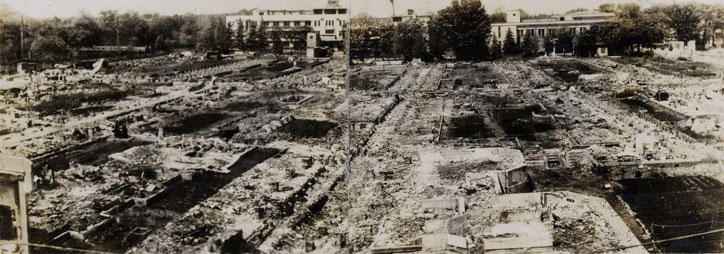
A monument commemorating the former site of the Institute of Diet and Nutrition is located in a corner of the Keio University Hospital grounds. The Institute of Diet and Nutrition, which survived the air raids, became home to several clinical departments and was used as a research facility. Amid the severe conditions of the postwar period, the site served as a shared research space and was long cherished by members of the School of Medicine. When the building was demolished in 1990, a portion of the outer wall was preserved, and a commemorative monument was erected.
The Keio University Hospital once had a 23-meter-long underground passage that connected the hospital wards, known as the “West Ward Underpass.” During the air raids, this tunnel was used to evacuate patients from the main hospital building to the annex. Today, the tunnel serves as a conduit for electrical wiring within the hospital.
Eighty years have passed since the end of the war in which so much was lost. We wish to turn our gaze to the efforts of those who strove to protect the light of education, research, and medicine on campus, and reflect on the memory of war and the yearning for peace as we strive to build a future guided by hope and harmony.
Footer start
Navigation start

